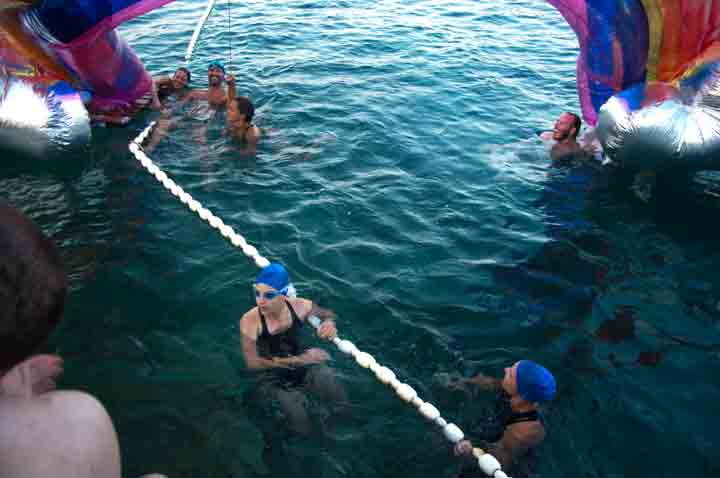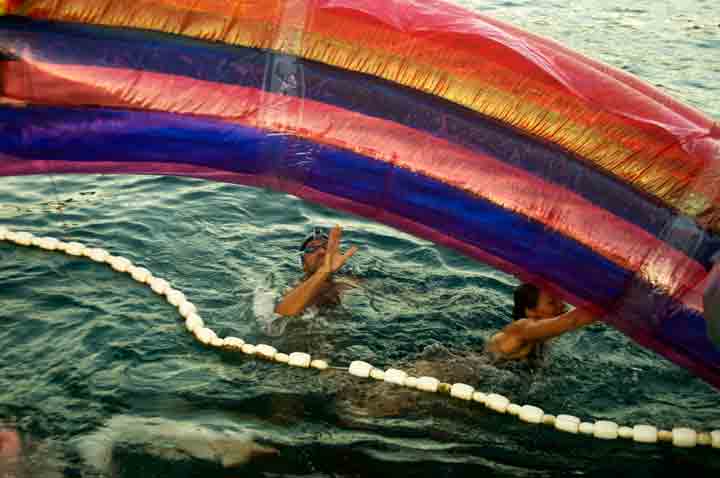Giant inflatable rainbow intervenes in Croatia´s annual swim race (Vis 2014)

At 6p.m. on Saturday the 16th of August on the paradise island of Vis in Croatia, the annual open water swimming event was expected to run as usual. Instead a giant inflatable rainbow carried by activists intervened in the closing section of the race to establish queer visibility in public space and sport, and to protest Croatia’s again increasing LGBTQ discrimination -recently coming in bottom (with Latvia) of the EU list of LGBTQ (2) friendly places. The focus on the ethics of sports is due to the fact that sports environments are very hostile to any minority involvement.

For sixteen years the swimming marathon on Vis has taken place over a 2,2 km distance. It is popular among local professionals as well as seasonal recreational swimmers. The biggest group in the past 3 years has been an informal team of LGBTQ swimmers and sport enthusiasts from Croatian clubs in Zagreb and Split. They have gained international attention due to the increasing brutality and homophobia that LGBTQs faced: in attacks on the first Split PRIDE in 2011 and the homophobic and sexist statements of Sport officials in Croatia that received global publicity. Only last week, the Croatian presidential candidate Mrs. Kolinda Grabar Kitarovic (National Democrats) said: “many gay people would not want to be regarded as homosexuals.” illustrating a return to Don’t Ask Don’t Tell style policy.

An 8 meter long inflatable rainbow flanked by shimmering silver clouds quickly inflated by an activist flashmob was waiting to meet the scores of swimmers close to the finish line of the 2.2km race. The symbolism referred to both the PRIDE movement and the long-held South Slavic superstition that passing under a rainbow changes an individual’s gender.

Tonka, a young coordinator in the recently opened LGBT center & group Rišpet in Split says:
’The Pop-up Rainbow was a fun and much appreciated experience that proves that activism can be stimulating and motivating and produce successful process based work.’
The major of Vis (National Democrats) insisted via the race organizers the rainbow protest not to take place - to suppress public display of LGBTQ groups (also organizing a big queer party on the night). However as he did not dare to make an official prohibition during the height of the tourist season, the intervention took place without official disturbances and with a colourful reaction from the public.
Artúr van Balen, Tools for Action: `The rainbow intervention was meant as a subtle provocation to challenge presuppositions about LGBTQ-people in the region of Dalmatia and Croatia in general. In a region where tradition and dogmatism sees homosexuality as something abnormal, we envisioned the inflatable pop-up rainbow as an eye catching surprise, a fatamorgana on the water that captures everyone’s´ imagination, regardless of their political views. The inflatable workshop was also meant as a support for queers in Croatia to be more open and confident in coming-out.´

Zeljko Blace, QueerSport : ‘The intervention highlighted the need for the public to be ‘loud and proud’ about sexual orientation and gender identity in public space - especially outside of the nexus of relations between Government, professionalized NGO activism and politricks of media PR. Most LGBTQ advocacy is within the Croatian capital of Zagreb and hugely normalized via the ”marriage equality” focus - highly diverted from the harsh LGBTQ realities on other levels and in rest of Croatia where more grass-root activism is much needed.’
Contact Details
QueerSport community works in social and cultural activism in sport & leisure
rainbow(at)qsport.info>.
Tools for Action creates inflatable intervention in cooperations with other art-, activist or community groups. info(at)toolsforaction.net
Notes to Editors
1. In the lead up to the intervention, two skill sharing workshops in inflatable making as engaged creative work were held in Zagreb and Split, with participants and contributors ranging from young DIY enthusiasts to expert engineers, from creative troublemakers to insightful critics, athletes, artists and activists. Initiators Artúr van Balen from Tools for Action and Zeljko Blace from QueerSport have previously been involved in a number of similar political, social and cultural projects in diverse contexts. Tools for Action’s work includes a 12 meter inflatable hammer that banged the fences of the United Nations climate change conference in Cancún, Mexico 2010, a 7 meter inflatable slipper that slapped patriarchy and supported women rights in India in 2013 and a 11 meter inflatable saw that protested corruption on the anti-Putin protests in 2013. QueerSport does annual QueerSport Weekends in Zagreb and critical sport laboratories in conjunction to EuroGames 2011 in Rotterdam - reflecting on insularity and normalization of a once progressive gay sport movement, Zagreb Pride 2013 - presenting possibilities and alternatives in sport activism in exhibition of “Another Sport is Possible?!.” in Zagreb and Rijeka in Croatia.
2. LGBTQ - Lesbian, Gay, Bisexual, Transgender, Queer, Intersex
Quality sites
- Casinos Not On Gamstop
- UK Online Casinos Not On Gamstop
- Nuovi Casino Online Italia
- UK Casinos Not On Gamstop
- Casino Not On Gamstop
- Casinos Not On Gamstop
- Casino Sites Not On Gamstop
- Casino Italiani Non Aams
- Online Casino
- Non Gamstop Casino UK
- Casino En Ligne Fiable
- Best Non Gamstop Casinos
- Best Non Gamstop Casinos
- Casino Not On Gamstop
- Casino Non AAMS
- UK Casinos Not On Gamstop
- Meilleur Casino En Ligne
- Slots Not On Gamstop
- Casino Sites Not On Gamstop
- Betting Sites






















